According to the Centers for Disease Control and Prevention (CDC), around 14 million falls are reported among older adults in the U.S. every year, with many occurring in the bathroom. Bathrooms can be filled with fall hazards due to slippery floors, wet surfaces, and hard-to-reach items. Additionally, traditional showers often have a raised step to enter, which can be difficult for some seniors and individuals with mobility challenges to navigate safely.
If you or a loved one is struggling to use a regular shower safely and comfortably, it may be time to think about a walk-in tub. In this comprehensive guide, we’ll go over everything you need to know about walk-in bathtubs for seniors and share some of our top recommendations.
What Are Walk-In Tubs?
Most traditional bathtubs have high sides that can be difficult to step over for people with limited mobility or balance issues. Walk-in bathtubs for seniors are specifically designed to make bathing safer and more convenient for older adults or anyone facing mobility challenges. These tubs often include essential safety and comfort features, such as non-slip flooring, grab bars, and comfortable seating. Some models even come equipped with water jets and handheld showers for added relaxation and comfort.
Why Choose Walk-In Tubs?
If you or a loved one is looking for a safer way to bathe, a walk-in tub can be a worthy investment. Here are a few key reasons why a walk-in tub can be a great addition:
- Added Safety: Most walk-in bathtubs for seniors are designed with additional safety features, like non-slip flooring, built-in grab bars, and a comfortable, raised seat, that can significantly reduce the risk of slipping or falling.
- Convenient Access: Bending or stepping over a regular tub can be challenging for some seniors, especially those with mobility challenges. Unlike a regular bathtub, most walk-in bathtubs for seniors feature a low-height, watertight door for more convenient access.
- Added Comfort: Some walk-in tubs are designed with built-in seating, so a person can sit comfortably while bathing.
- Independence: Walk-in bathtubs for seniors can make bathing safer and more manageable, particularly for seniors or people with mobility challenges. This not only reduces the risk of falls but also helps promote a sense of dignity and independence.
- Peace of Mind: The added safety of walk-in bathtubs for seniors can provide peace of mind for caregivers.
Types of Walk-In Bathtubs for Seniors
When choosing a walk-in tub, it can be helpful to know the different types available to find the one that best fits you or your loved one’s needs. Here’s a rundown of the most common types of walk-in baths for seniors:
- Standard Walk-In Tubs: These are the basic option and typically feature a side watertight door that makes it more manageable to step in and out. Standard walk-in bathtubs for seniors are a great choice for those looking for a safe and affordable bathing experience.
- Soaker Walk-In Tub: A soaker walk-in tub is a great choice for those who love a deep, relaxing bath. Unlike regular walk-in tubs, which might not be as comfortable for long soaks, soaker walk-in tubs have a deeper basin that allows users to enjoy a full-body soak.
- Bariatric Walk-In Tub: Bariatric walk-in tubs are designed to provide extra space and support for larger individuals. They usually have a wider seat and a stronger, sturdier build to safely accommodate more weight.
- Wheelchair Accessible Tub: This type usually comes with a wider door and a lower entry step that can make it more manageable for users to transfer from a wheelchair to the tub. Some models also include built-in transfer seats and extra space to move around comfortably.
- Hydrotherapy Walk-In Tub: A hydrotherapy walk-in tub is an excellent choice if you’re looking for a way to enjoy therapeutic benefits while bathing. They’re typically equipped with built-in water jets that can provide a gentle massage to help relieve sore muscles, ease joint pain, and improve blood circulation.
- Tub and Shower Combo: This type of walk-in tub combines the features of a traditional bathtub with those of a shower. Most tub and shower combos include a handheld showerhead. This makes it easier to reach all areas of your body and is also handy for cleaning the tub.
- Two-Seater Tub: If you enjoy sharing bath time with a loved one, a two-seater tub might be ideal. This model includes space for two people to bathe comfortably at the same time. It’s a great option for couples or for those who need assistance while bathing.
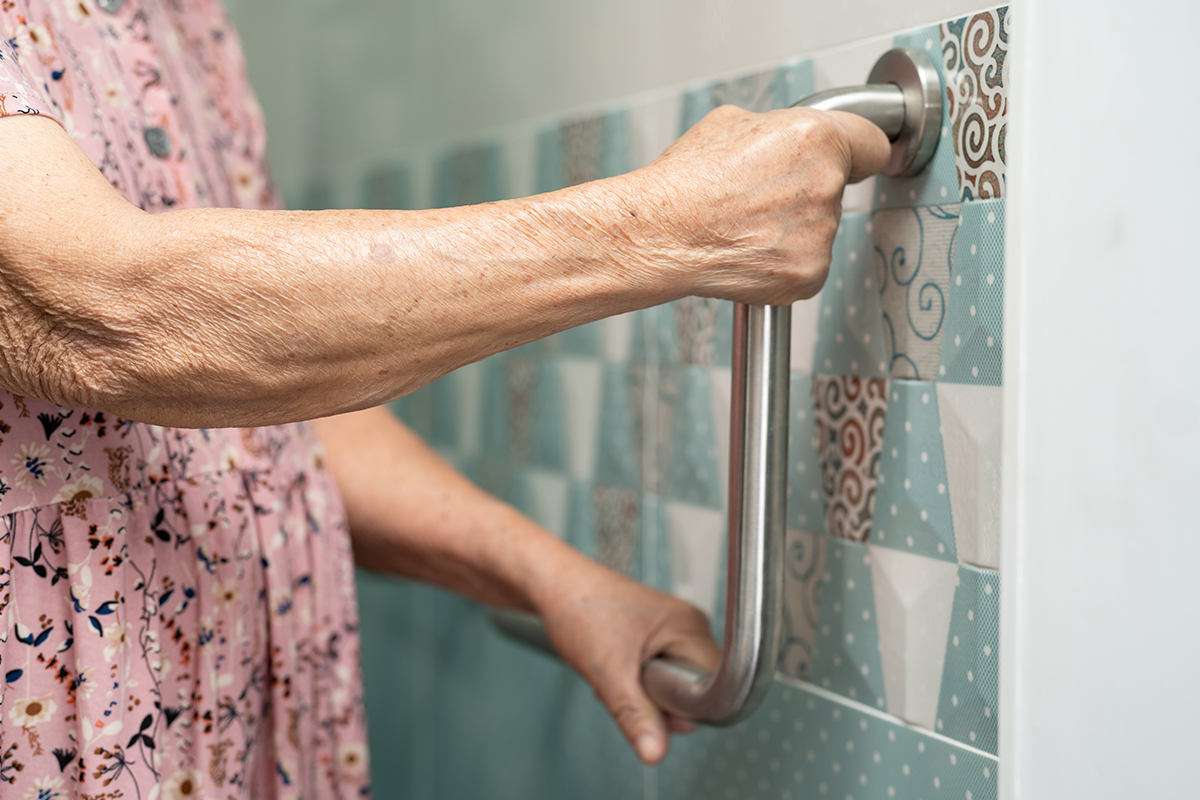
Key Features to Look for in Walk-In Tubs
When selecting a walk-in tub for yourself or a family member, it’s important to prioritize features that cater to your unique needs and circumstances. Here are some key aspects to keep in mind:
- Low Entry Step: When considering walk-in bathtubs for seniors, it can be helpful to look for a walk-in tub with a low entry step. This can make it safer to step in and out of the tub without lifting a leg as high.
- Comfortable Seat: A built-in seat should be both sturdy and comfortable, especially for those who need to sit while bathing. Some models even feature adjustable seats or contoured designs for added comfort while bathing.
- Non-Slip Flooring: Non-slip flooring can significantly reduce the risk of falls, especially when the tub is wet. Make sure the tub has a textured surface for added grip.
- Grab Bars: Grab bars can provide extra support when getting in or out of the tub. During installation, it’s crucial to make sure they’re securely placed where they will be most useful for you or your loved one.
- Door Design: Check the door to ensure it seals tightly to prevent leaks. Some doors open outward, while others swing inward. You can choose one that works best for your bathroom layout.
- Water Jet Options: If you or a family member is interested in hydrotherapy, consider a tub with built-in water jets. These jets can help soothe sore muscles and offer a relaxing massage. However, keep in mind that adding these features may increase the cost of the tub.
- Handheld Showerhead: Some tubs come with a flexible hose to help users direct the water where they need it. This feature can be especially helpful for older parents or people with limited mobility.
- Easy-to-Use Controls: The controls for water temperature and any additional features should be simple to use. Look for designs that are straightforward and user-friendly.
- Safety Features: If you’re considering a walk-in tub for someone with mobility or balance issues, it can be a good idea to prioritize additional safety features, like an emergency drain button, a built-in safety seatbelt, or an automatic drainage system.
- Size and Shape: Before making a decision, it’s important to make sure the tub fits comfortably in your bathroom and meets your space requirements.
Our Top Picks
When it comes to choosing the perfect walk-in tub, there are several great options to choose from, depending on you or your loved one’s needs and preferences. Here are some of our best recommendations:
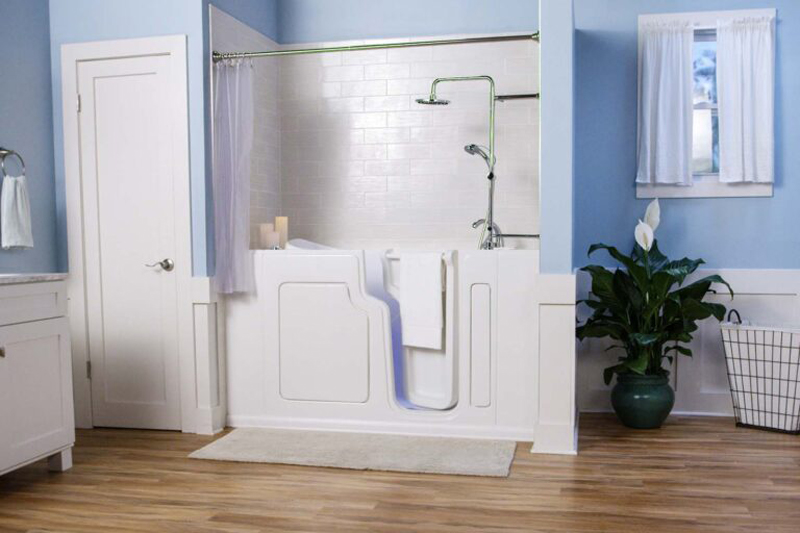
Best Overall: Safe Step Walk-In Tub
In addition to the standard safety features, like a watertight door and anti-slip floor, the Safe Step Walk-In Tub is packed with a lot of helpful features, including a proprietary anti-scald technology, ergonomic handles, built-in grab bars, and more.
Pros:
- Safety: Low entry step and grab bars help prevent slips and falls
- Comfort: Comfortable seat and optional hydrotherapy jets
- Ease of Use: Simple controls and convenient access
Cons:
- Cost: It might be more expensive than some basic models
- Space: Requires a bit more space for installation
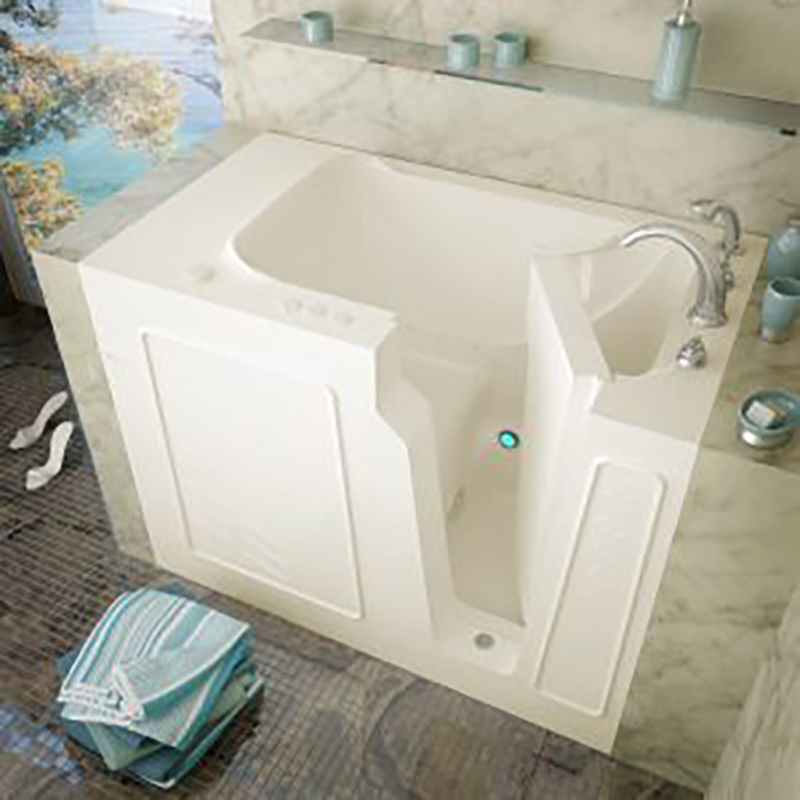
Best Safe Tub: Meditub Walk-In Tub
The Meditub Walk-In Tub is a great option for those who prioritize safety while bathing. It features an inward swinging door and an ADA compliant seat for added safety and comfort. It also features a quick-drain system that allows users to drain the tub faster if needed.
Pros:
- Safety: Non-slip flooring and low entry step
- Therapeutic Benefits: Includes air and water jets for a relaxing experience
- Quick Drain: Faster water removal for convenience
Cons:
- Jet Options: Extra features may add to the cost
- Maintenance: Additional features may require more upkeep
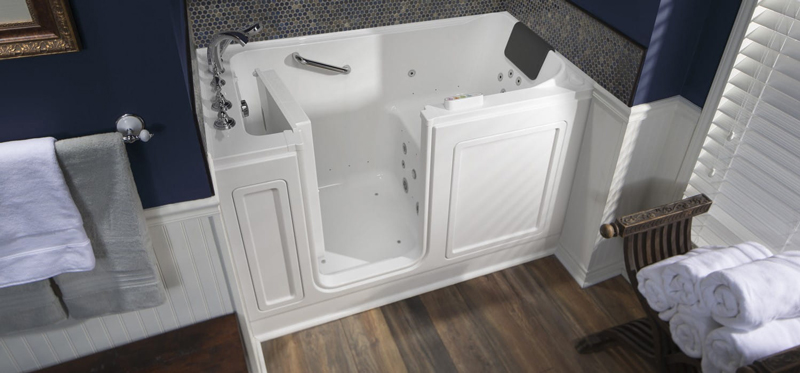
Best Soaking Tub: American Standard Walk-In Tub
The American Standard Walk-In Tub has a deeper basin compared to standard tubs, making it perfect for those who love to enjoy a deep soak.
Pros:
- Accessibility: Wide entryway
- Safety Features: Textured anti-slip floor and grab bars
- Comfort: Built-in ADA compliant seats and neck rest
Cons:
- Size: The deeper design might require more bathroom space
- Cost: Higher-end features may increase the price
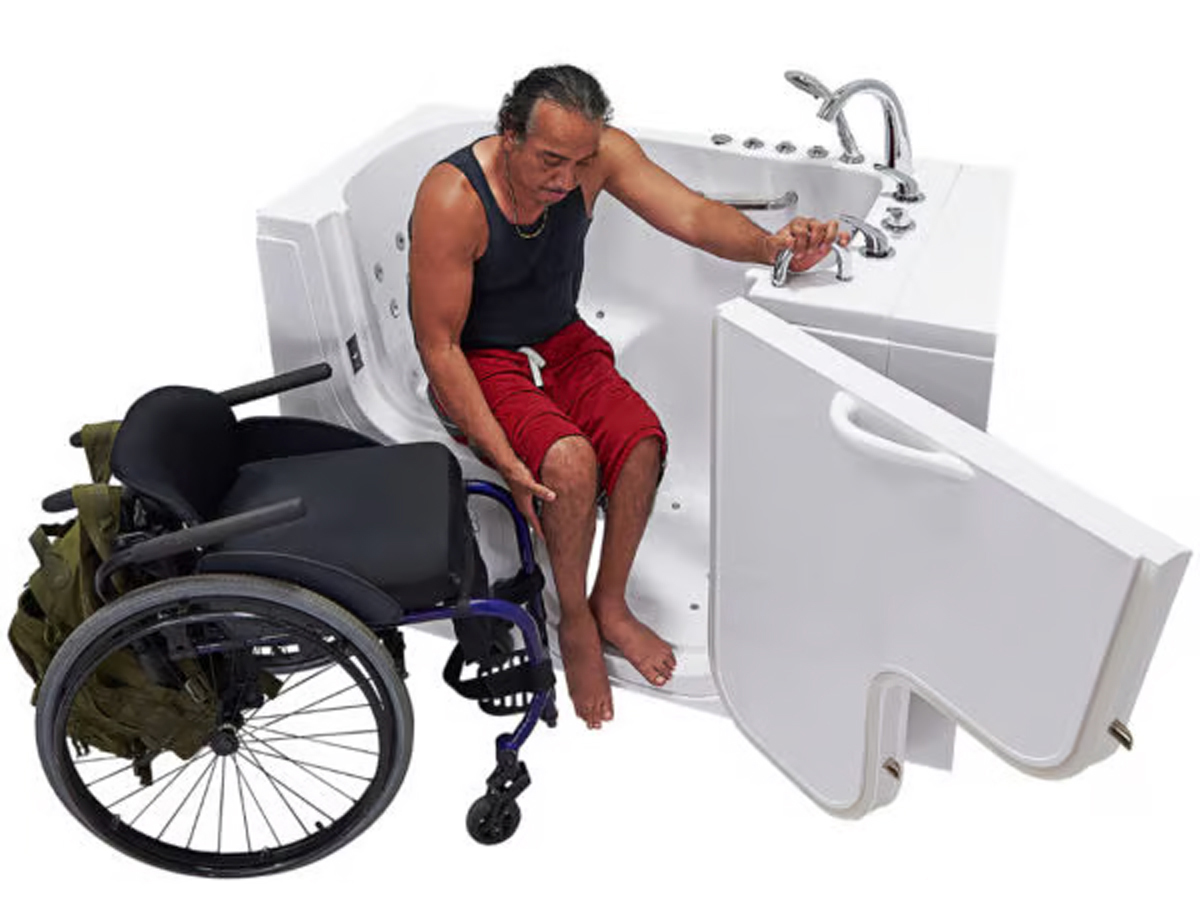
Best Wheelchair-Accessible Tub: Ella Transfer Walk-In Tub
The Ella Transfer Walk-In Tub features a low entry step and ample space to make transferring from a wheelchair safer and more convenient. It also has built-in grab bars and an outward swinging door for added accessibility.
Pros:
- Accessibility: Spacious design for easy transfers
- Safety: Built-in grab bars and comfortable, anti-slip seating
- Space: Designed to accommodate wheelchair users comfortably
Cons:
- Space Requirements: Larger footprint may need more room
- Cost: Wheelchair-accessible features may add to the price
Notable Mentions:
We’ve done our best to share our top recommendations, but there are still more great walk-in bathtubs for seniors out there. Here are a few more options that are definitely worth considering:
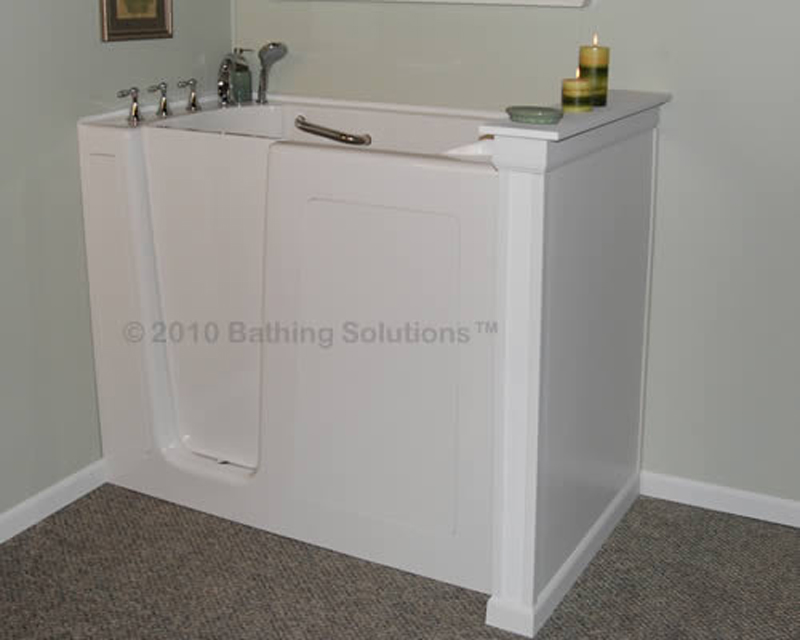
Bathing Solutions Walk-In Tub
This tub features a non-slip floor, handrails, quick-drain feature, and more, making it a versatile option for most people.
Pros:
- Customization: Options for heated backrests and massage jets
- Safety: Non-slip floor and easy-entry doors
- Comfort: Hydrotherapy jets can be adjusted to suit your preferences
Cons:
- Price: Custom features can increase the overall cost
- Complexity: More features may be confusing for some people
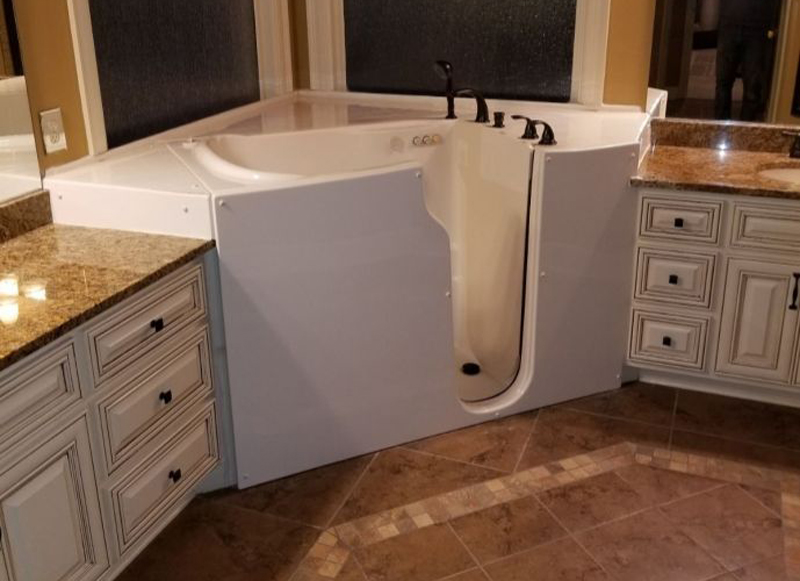
Boca Walk-In Tub
If you’re looking for a reliable and sturdy tub that offers a bit of extra room, the Boca Walk-In Tub is an excellent option.
Pros:
- Space: Spacious interior for added comfort
- Safety: Anti-skid material on the seat and floor to prevent slips, and a quick-drain feature.
- Comfort: ADA-compliant seat height
Cons:
- Basic Features: May lack some advanced features of higher-end models
- Space: Requires sufficient room for installation
Cost of Walk-In Tubs
When choosing a walk-in bathtub, budget might be a key consideration. The cost of a walk-in bathtub can vary widely, depending on the features and quality. Here’s a general overview to help you understand what to expect:
- Basic Models: Basic walk-in tubs typically start around $2,000 to $4,000. They often include essential safety features, like a side door, a built-in seat, and non-slip flooring. They are a great option for those looking for a safe and comfortable bathing experience without added comfort features.
- Mid-Range Models: You can expect to pay between $4,000 and $6,000 for mid-range models. Most mid-range walk-in tubs for seniors come with additional features such as a handheld showerhead, upgraded materials or enhanced safety features, like grab bars.
- High-End Models: For those who desire more advanced features, like hydrotherapy jets, higher-quality materials, or personalized designs, prices can range from $6,000 to $10,000 or more.
- Installation Costs: Don’t forget to factor in the cost of installation, which can add $1,000 to $3,000 to the total. Professional installation is generally recommended to ensure the tub is properly fitted and sealed to avoid any leaks.
- Additional Costs: Some models may offer extra features, like specialized water filtration systems or custom modifications, at a higher price. Be sure to ask about any additional costs when getting a quote.
Installation Process
Installing a bathtub can take one to three days, depending on how much work is needed. Here’s an overview of what you can expect:
- Planning and Assessment: The first step is to have a professional visit your home to assess your bathroom and determine where the new tub will go. They’ll measure the space to ensure the tub will fit and check if any adjustments are needed for plumbing or electrical systems.
- Removing the Old Tub: The next step is taking out the old tub. This typically involves disconnecting the water pipes and carefully removing the old tub, then cleaning up the area.
- Preparing the Space: Next, the area where the new tub will go needs to be prepared. This might include adjusting the plumbing lines or making sure the floor is level so the new tub fits perfectly.
- Installing the New Tub: It’s now time to put the new walk-in tub in place! This includes connecting the water pipes and drainage, sealing the tub to prevent leaks, and making sure everything is secure.
- Testing: After the tub is installed, it’s important for the professional to test it to make sure it works properly. They should check for any leaks, ensure the door seals correctly, and test all the controls
How to Choose the Right Option
With many types of walk-in bathtubs available, it’s important to choose one that meets the specific requirements you or your loved one might have. Here’s a helpful guide to make the decision smoother:
- Assess Your Needs: Start by thinking about what features are most important. Do you need extra space, a deep soaking experience, or perhaps hydrotherapy options? It’s also a good idea to consider any mobility challenges or specific comfort needs you or your loved one might have.
- Measure Your Space: Walk-in bathtubs come in various sizes and shapes, so it’s crucial to choose one that fits your bathroom without needing to make major changes to your layout.
- Check the Entry and Exit: Look for a walk-in tub with a low entry threshold and a door design that’s easy to use. This can make getting in and out of the tub safer and more convenient.
- Evaluate Safety Features: Ensure the tub has essential safety features, like non-slip flooring, grab bars, and a comfortable, supportive seat.
- Consider Comfort Options: It’s important to prioritize features that will make the bathing experience most enjoyable for you or your family member.
- Look at Additional Costs: While some models might have extra features or custom modifications, these usually come with an additional cost. You can ask about any additional fees when you get a quote to avoid surprises.
- Read Reviews and Ask for Recommendations: Look for reviews from other users to see how well the tub performs and if there are any common issues. You might also ask friends, family, or healthcare professionals for their recommendations.
- Test the Tub if Possible: If you can, try out the tub before making a final decision. This can help you ensure it suits you or your loved one’s specific needs.
Frequently Asked Questions About Walk-In Tubs
If you’re considering a walk-in tub, you probably have some questions about costs, coverage and maintenance. We’ve gathered answers to some of the most common questions people have about walk-in bathtubs for seniors:
Will Medicare pay for a walk-in bathtub?
Medicare usually doesn’t cover the cost of walk-in bathtubs. Medicare focuses on covering medical expenses, and since walk-in tubs are considered home modifications rather than medical equipment, they generally aren’t covered. However, you might want to check with Medicare directly or consult with a financial advisor to explore any possible options or assistance programs.
How much are walk-in bathtubs?
The cost of walk-in bathtubs can vary widely, depending on the features and style you choose. On average, they can range from about $2,000 to $5,000. More advanced models with hydrotherapy jets or custom features can cost more. It’s a good idea to get quotes from different suppliers and compare options to find the best fit for your budget.
Will Medicaid pay for a walk-in tub?
Medicaid coverage for walk-in tubs may vary depending on where you live. In general, Medicaid might cover some costs if the tub is deemed medically necessary and if it meets certain criteria. It’s important to check with your Medicaid provider and review your state’s specific guidelines to see if you qualify for any assistance.
Are walk-in bathtubs difficult to maintain?
Most walk-in bathtubs for seniors come with easy-to-clean surfaces and sturdy construction. To keep your tub in top shape, make sure to clean it regularly and check for any leaks from time to time.
Where should I buy a walk-in bathtub?
You can buy walk-in bathtubs from several sources, including home improvement stores, specialty bathroom retailers, and online marketplaces. It’s a good idea to research and read reviews about different brands and retailers. You might also consider consulting with a professional who specializes in bathroom modifications to help you choose the best option.
How much does it cost to install a walk-in bathtub?
The installation cost for a walk-in bathtub can vary depending on your home’s setup and the complexity of the installation. On average, installation can cost between $1,000 and $3,000. It’s important to get a detailed estimate from a licensed installer and ensure that the installation is done correctly to avoid any issues down the road.
Senior Living With StoryPoint Group
At StoryPoint Group communities, we’re more than just a place to live — we’re family. That’s why our team takes the time to understand each resident’s individual needs, so we can provide the best experience tailored just for them.
To learn more about life at StoryPoint Group communities, contact us today at 1-844-275-9990 or schedule a tour of a community near your location.











